By Jeffrey A. Rendall, Photos By Jeff Janas
BRIDGEPORT, WV -- "If someone asked me if there was anything unusual about the Pete Dye Golf Club project, I'd say it was dealing with all the gob," remarked the club's namesake, Pete Dye, when questioned on the layout's soft spot in his memory.
Wholeheartedly admitting that I hadn't a clue what gob is, I looked it up in Webster's Dictionary: "a lump or mass, as of something soft," read one definition. "Waste material produced in coal mining, consisting of clay, shale, etc," said another.
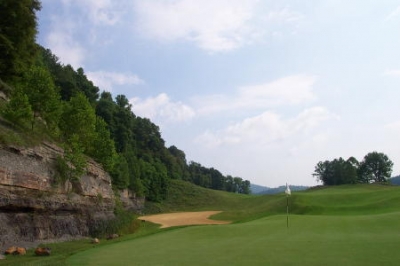 |
| Is it golf or nature? Sometimes at the Pete Dye Golf Club, it's hard telling one from the other. Here, the par five 8th hole. |
Now that's more like it. The Pete Dye Golf Club occupies 500 acres of hill country in Bridgeport, West Virginia -- land formerly used as part of a coal mining operation. Bridgeport is near Clarksburg in the north-central part of the state, and it doesn't take long to figure out that this region's primary industry concerns that crusty black fossil fuel rock.
That's also why it seems a bit strange to put a golf club here, especially an exclusive private club with a tremendous amount of capital investment going into creating the place. The Dye Club's promotional materials claim that it's within four hours' drive of 60% of the US population -- which may be true, but there probably isn't a major city within two hours, in any case.
Not that the Club's suffered from its geographic separation from urban humanity. When embarking on a mission such as this, you'd like to think 'if you build it, they will come,' -- yet if your finished product isn't worth the effort, then 'forget it, they won't come.' The folks behind the Pete Dye Club took that chance, and it's paid off in what many call one of the finest modern golf course designs in the country, if not the world.
It all started back in 1978, when the LaRosa family (James LaRosa is the President of the Club) got a hold of 500 acres of abandoned, formerly coal-mined land and contacted legendary designer Pete Dye about transforming the somewhat desolate landscape into a golf club. Some folks must've thought they were crazy, but every great outcome was probably the result of a fringe idea at some point.
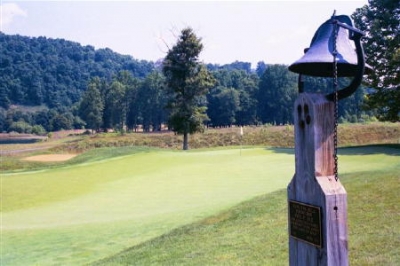 |
| Ring the bell after finishing the 341 yard, par four 12th hole. Someone might try to drive the green, but the best play is definitely to lay-up. |
Dye said the challenge of converting the land was the most rewarding aspect of the project: "When I first saw the property, it was all gob, and had some other real serious issues, such as poor water and the absence of enough flat ground. I saw that the mountainsides were just unbelievably beautiful with all the trees and the long views, but I told 'em they really needed something flatter."
He continues: "Of course, getting anything flatter up there is hard to find. The coal mining had also created some usable plateaus -- when they mine the coal, they cut into the sides of the hills and that makes some more level spots. We put a few holes on those plateaus, like six, eight, eleven and twelve."
"So, all we had to do was take the gob out, and try to grow some grass up there. It was a lot of fun working with those folks on restoring that beautiful piece of property -- we redid that whole valley, taking what was probably some pretty worthless land and making it attractive again," Dye said.
If it sounds difficult, it was. Dye said another thing about the Pete Dye Club he'll always remember was how long it took to finish it. "It took forever to finish that darn thing, near ten years. We kept taking coal out, and doing this and that, and getting rid of the debris. That 'stuff' wasn't good for anything else, so we just had to get rid of it."
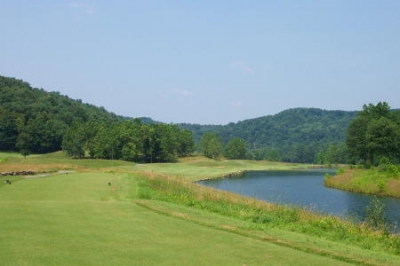 |
| If there's anything 'tame' about the Pete Dye Golf Club, it's the par fives. Here, the 533 yard, par five 15th hole. |
The course's lengthy construction period also factored into the naming of the club: "A friend of Mr. LaRosa's came up with all sorts of great names, these Scottish names. Then Jim (LaRosa) said, 'Well, I've got a great name for this golf course -- we'll call it the Pete Dye Club,'" Dye mused.
"I told him I don't care what you call the doggone thing, let's just get it done," Dye laughed. "So, we had an agreement, and I said go ahead and call it anything you like -- and that was that."
It is an interesting story, but the golf course itself is a feat of imagination combined with what must've been some serious technical know-how. Dye preserved much of the property's mining heritage within the context of the golf holes, and what could easily have ended up a theme-based, goofy adventure ride of a golf course is now a tribute to environmental reclamation on a grand scale.
You'll see references to the land's past at nearly every turn, and that's appropriate in this part of the country. You'll even have the chance to drive through an old mineshaft to reach the seventh tee, if you so choose.
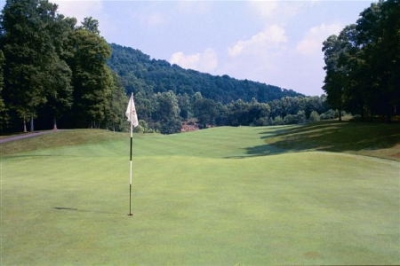 |
| You can't see it from this view, but the par four ninth hole (462 yards) has a horizon-wide tee shot landing area. The second shot is another matter entirely. |
And don't forget the layout. It's as difficult or as mild as you'll want it. Jeff Koski, Director of Outside Golf Operations at Pete Dye Club, says playability is always the major goal: "I think anyone from a scratch player to a 30+ handicap, including women, can find a set of tees here at Pete Dye Club, and have a good time. This course is very challenging, but you can reduce the difficulty significantly by moving forward from the championship tees."
The reason being forced carries. We took on the Pete Dye Club from those back tees -- all 7166 yards and 148 slope of it -- and I'll admit, it kicked our butts. But unlike some other mountain-style courses we've seen, this one wasn't horizontally problematic. If anything, the landing areas for tee shots were exceedingly wide. It's not likely you'll lose balls here unless you're shaping shots the wrong way -- but if you can't place your tee ball in the proper places in the shorter grassy areas, then it's a really tough test.
Koski describes it: "Dye gives you the opportunity, when you're hitting the ball well, to score well. Even if you're not precise, as long as you're missing in the right spots, like where there are collection areas, you can still make good scores -- but you'll have to make a great recovery."
Ah, the collection areas. They're so large at Pete Dye Club that Goodwill Industries, the Red Cross and the Salvation Army could hold collection drives simultaneously and still have room left over to park the trucks. From the first hole on, they're omni-present. Dye's said in the past that he likes to leave a lot of room off the tee, but he'll dream up some short shots to challenge your imagination in virtually every circumstance. Pete Dye Club may be the finest embodiment of this philosophy that we've ever seen in a Dye layout.
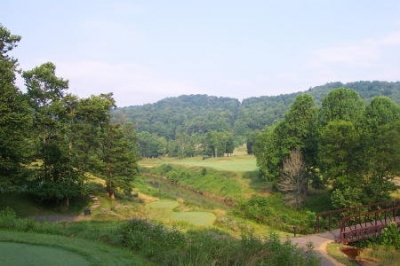 |
| A fearless golf ball is needed here at the 435 yard, par four 2nd hole. It may not look like it, but there's a lot of room out there once you've cleared the ravine. |
Even if you reach the putting surfaces, the undulations will test the putter blade. Hitting greens in regulation isn't enough -- here, if you're not on the right level, there will be many three-putts (this is what got us the most, a record number of three-putts).
The bunkering, as you'd expect on a Pete Dye inspired course, is another element protecting par. Simply put, sand's well represented on the layout, and those indentations are some deep traps. Yet another area where imagination is paramount to try and beat the golf course.
As attention grabbing as the golf is, the service at Pete Dye Golf Club is as impressive as the scenery. Starting with the valet parking when you drive up, your entire day is taken care of for you, courtesy of the polite but not overbearing staff.
Koski says the service goes beyond what you see at the club: "A good percentage of our membership is from outside the area, so we've developed some services that take that fact into account. There's an airport approximately eight miles from here (with multiple daily flights from Pittsburgh and Washington Dulles), and we provide limo service to and from the airport. We really go the 'extra mile' to make our members and their guests feel extremely comfortable. Whatever it takes, we'll do."
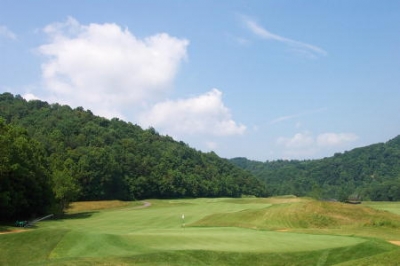 |
| The par five 11th hole is carved into one of those plateaus that Pete Dye was referring to. You'll still need to be accurate, and at 604 yards, long, too. |
There're even overnight accommodations on-site. And the 24,000 square foot clubhouse will take care of the balance of your needs. You could get lost in those locker rooms if you're not careful.
Out on the course, there's one highlight after another. Koski says he avoids naming 'signature' holes, because every link at Pete Dye is unique and special. That's no exaggeration. Once you manage to get past the scale of the course, you can settle down to shoot some golf. But it's an adjustment, take my word for it.
Personal favorites include the second hole, a 435 yard par four with one of the most incredible tee box views you'll ever see. Like much of the course, trouble looks like it's everywhere, but the landing area's quite wide. The second shot, however, will challenge you to hit the green -- and if not, one of those collection areas is just waiting to find you.
The seventh hole probably rates high on everyone's list. 196 yards and downhill from the tips, the view is one of pure intimidation -- there's a fairly large green, but it's surrounded by sand bunkers, chipping areas and tall grass. This hole alone demonstrates the visual mastery that is Pete Dye. It's also the hole where you can drive through the mineshaft to get to the tee box.
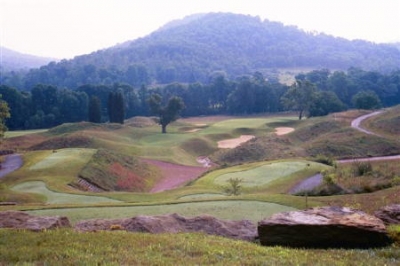 |
| Here, the green's by the bunkers on the par three 7th hole. One of the most spectacular sights you'll get in golf, but putting the ball in the hole is another matter. |
Eight measures 'only' 504 yards (par five), but the green won't surrender un-earned low scores. What's most notable about the hole is the rock cliff bordering its right side, then the mineshaft that's perched near the green. A lot of hard work went on here over the years, and even if you miss the putt, that's there to remind you it could be worse.
The back nine is another series of hole-after-hole highlights. The tenth hole features a spectacular waterfall to the right side of the hole -- which slicers might find if they're not mindful of their tendencies.
The 11th hole is a tremendous, 604 yard, three-shot par five with another outstanding, thought-provoking green. The twelfth hole has a bell to ring when clearing the green -- which usually indicates you might be able to drive it. For those who try, best of luck.
It pains me to skip to the 17th hole, but this link has one of the most unusual greens you'll ever encounter. Koski describes it: "The 17th green is probably the most undulating on the course. It's essentially an island green without water. If you're on the green, you won't have a flat putt -- but if you're off, it'll be a great up and down to save par. What tremendous imagination it took to create that hole."
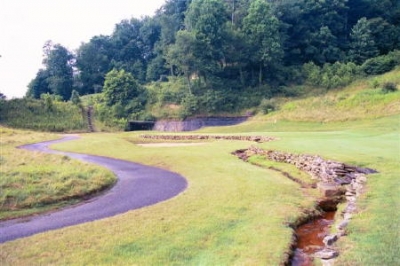 |
| The short par four 6th hole features this creek up the entire left-hand side of the hole. |
Eighteen's another classic, difficult Dye closing hole. 453 yards in length, take your draw swing here and get it out there as far as possible -- because the second shot will take all you've got to try and get it close. It reminded me of some of the other classic Dye finishing holes at Bulle Rock, Harbour Town and Lost Canyons (in Simi Valley, CA).
The Pete Dye Golf Club shatters quite a few illusions. You'll have a hard time believing that such a course could be built in this type of terrain -- but you'll also scarcely fathom that someone would try. It's a course and club that would easily lead to continuing interest over the seasons. Koski says with the changing pin positions, that the course never plays the same, day after day. That's definitely the truth -- and we're glad that Pete Dye once again worked his magic, turning gob into gold... or should we say, golf.
Details:
Pete Dye Golf Club
801 Aaron Smith Drive
Bridgeport, WV 26330
Phone: (304) 842-2801
Website: www.petedye.com
Course Designer: Pete Dye
Director of Outside Golf Operations: Jeff Koski
Owner: James L. LaRosa
|
Tees |
Yardage/Slope |
Rating |
|
Championship |
7166/148 |
76.2 |
|
Back |
6750/140 |
73.9 |
|
Dye |
6218/135 |
71.6 |
|
Middle |
5763/124 |
69.6 |
|
Front |
5127/119 |
69.2 |
Rates:
| Related Links | Comments on this article? | |
|
Maryland National Golf Club Hollow Creek Golf Club Rocky Gap Resort PB Dye Golf Club in Ijamsville Whiskey Creek Golf Club |
E-mail Jeff Rendall, Editor: jrendall@golftheunitedstates.com |











